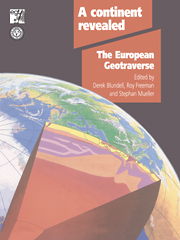Preface
Published online by Cambridge University Press: 05 November 2009
Summary
The European Geotraverse (EGT) project has been a scientific undertaking on an unprecedented scale in the Earth Sciences. Its whole ethos has been founded on the idea that the scale of trying to understand the workings of a continent and its evolution through geological time demanded the combined efforts of a very large number of people with expertise from a wide range of disciplines. Not only would they have to understand each other's point of view and work together in a series of integrated experiments, they would have to produce their findings in such a way that could be understood by all. EGT completed its experimental work in 1990, the culmination of nearly ten years effort. But the work of EGT could not end there. The concluding paragraph of the EGT Final Report to its prime supporter and benefactor, the European Science Foundation (ESF), made clear that ‘In many ways, EGT has only just begun'. The wealth of data collected during the EGT experimental programme, together with geological and geophysical data obtained over many years, were reduced to a common reference frame and mapped on to a common scale and projection in order to compare them directly so that the connections between them might become clear. The result of this compilation is the sequence of maps and plates, together with explanatory text and comprehensive reference lists, that form the EGT Atlas which is the complement and companion to this book. To enhance the use of this database, much of the Atlas data is contained on a CD-ROM.
- Type
- Chapter
- Information
- A Continent RevealedThe European Geotraverse, Structure and Dynamic Evolution, pp. ix - xiPublisher: Cambridge University PressPrint publication year: 1992



